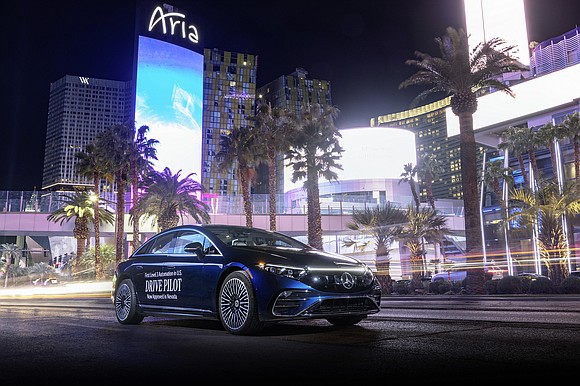Mercedes leapfrogs past Tesla on automated highway driving
CNN/Stylemagazine.com Newswire | 1/27/2023, 1:06 p.m.

Originally Published: 27 JAN 23 11:58 ET
By Peter Valdes-Dapena, CNN Business
(CNN) -- Mercedes-Benz will take a step towards offering a self driving car in the United States, or at least in some states, when it begins selling cars featuring its new Drive Pilot system later this year.
Mercedes' Drive Pilot system is designed to work on highways in dense traffic at speeds of less than 40 miles per hour. Unlike traffic jam assist features already available throughout the US on a number of luxury models today, including Mercedes-Benz cars, the Drive Pilot system allows the driver to entirely disengage from the act of driving. When the system is in operation, Mercedes considers it safe for the driver not to pay attention to the road -- although the driver still has to be ready to take back control if needed, such as if the traffic situation changes or if the system encounters an unusual situation it's not capable of handling.
The Mercedes system is considered Level 3 Automation, as defined by the Society of Automotive Engineers. It's more automated than a Level 2 system, like Tesla's Autopilot, General Motors' Super Cruise and Ford's BlueCruise, in which the vehicle's brakes and steering operate on their own in certain situations but the driver is still required to pay attention to the road at all times.
In a Level 3 system, "You are not driving when these automated driving features are engaged - even if you are seated 'in the driver's seat,'" according to the SAE
The driver could, for instance, check emails on their phone or watch a video. Even Tesla's Autopilot and so-called "Full Self-Driving" technologies require that the driver pay attention to the road outside the car at all times.
"In the modern world, time is one of the most precious commodities, and giving back time to our customers is a core element in our strategy to build the world's most desirable cars," said Markus Schäfer, chief technology officer for Mercedes-Benz.
The system complies with Nevada's traffic regulations for autonomous vehicles, according to Mercedes, which says it hopes to get certification in California soon. The system will be available on model year 2024 Mercedes EQS and S-class models, which go on sale in the US later this year. The system will only work on certain mapped highways in states where it has been deemed legal such as Nevada and, possibly soon, California.
Among other technologies, the Mercedes system relies on lidar, which is similar to radar but uses laser light, rather than radio waves, to detect objects in its surroundings. Lidar can provide much more detail about a vehicles' surroundings than radar or cameras alone and many experts feel it is a necessity for safe autonomous vehicles. Elon Musk, the CEO of Tesla, however, has said cameras alone are sufficient.
The Mercedes system also uses a rear-facing a camera in the back window, a microphone to listen for emergency vehicles and road wetness sensors inside the wheel well. It also relies on high-definition three-dimensional mapping data that's regularly updated as well as an ultra-precise vehicle positioning system that's much more accurate than ordinary GPS, according to Mercedes-Benz.



